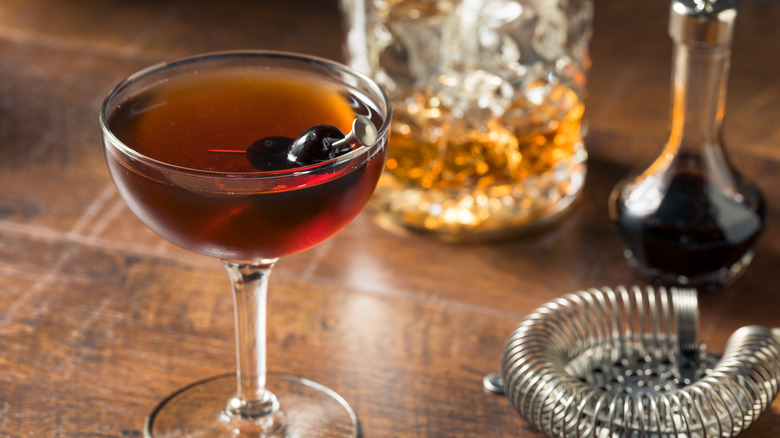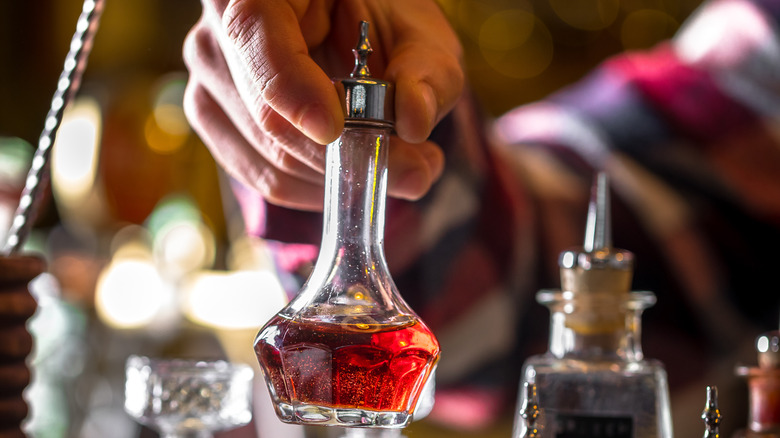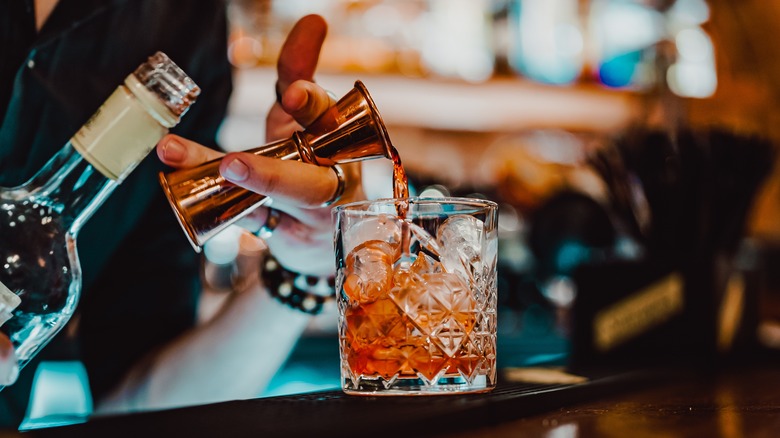Bitters Can Make Or Break Your Homemade Cocktails
It's true that cocktails can be intimidating. Reading a cocktail menu at your local bar can require multiple Google searches to decipher the often complex ingredients. So, when left to your own devices, it might be tempting to stick to the standard rum and coke or gin and tonic rather than attempting an old fashioned. But there is one simple ingredient that can help you live out your mixologist fantasies, and that's bitters.
Now, perhaps the topic of bitters is just as, if not more, opaque than cocktail craft. They have a mysterious, almost medicinal reputation and feature intense, herbaceous flavors that can, if overused, overpower a drink. However, bitters, when used properly, can take your drink to the next level.
Bitters usually consist of high-proof neutral alcohols infused with herbs, fruits, roots, or spices to create a punch of flavor. Bitters usually have a very high alcohol content, sitting at around 35-45% alcohol by volume. This doesn't mean you should avoid them if you prefer a lower alcohol content. Bitters are added to drinks in very small amounts. A few dashes of bitters in a drink can enhance its flavors without a heavy dose of alcohol.
The purpose of bitters is to enhance your cocktail with the addition of strong and complicated flavors that can help to marry disparate cocktail ingredients or highlight the flavor of your alcohol of choice. It's important to know how and when to use your bitters to enhance your drinks.
From doctor bags to bar carts
Infusing alcohol with herbs is not exactly a new idea. The ancient Egyptians often infused wine with herbs, for example. But bitters as we know them didn't come to be until the 19th century. And even then, they weren't used to enhance drinks, but as a medicine. In colonial America, bitters were added to drinks in order to treat various ailments. Angostura bitters, for example, were created to treat such maladies as sea sickness and stomach aches.
However, the medical benefits of bitters were, for the most part, total bunk. The drink's popularity dipped in the early 20th century when the American government put regulations on patent medicines such as bitters, which often made unfounded claims regarding their medical benefits. Bitters faced another stumbling block when Prohibition was made law in 1920 and only a few of the original brands were able to stick it out through the drought in business.
In recent years, however, bitters have made a resurgence in popularity thanks to an uptick in the craft of cocktail making. And any bartender worth their salt has at least one trusty bottle of bitters to help make the most of their cocktails.
What bitters make better
The first step to understanding how to use and enjoy bitters is to differentiate between potable and non-potable varieties. Potable bitters are bitters that can be enjoyed with a cocktail or on their own. Bitters of this variety include vermouth, Campari, and the recently popular Aperol, best known for its use in the trendy Aperol spritz. Meanwhile, non-potable bitters should not be enjoyed on their own and should be added to cocktails in very small amounts. These bitters tend to come in smaller bottles and feature clear plastic caps called orifice reducers to help prevent over-pouring.
But beyond potable and non-potable, there are several key varieties of bitters to become familiar with if you'd like to try your hand at cocktail craft. The primary varieties of bitters are aromatic bitters, orange bitters, celery bitters, and digestive bitters. Digestive bitters are potable and include drinks like Aperol and Campari, and can often be enjoyed on the rocks or as a primary ingredient in different cocktails.
Aromatic bitters, meanwhile, can lend an herbaceous flavor to your drink. They are often used in cocktails such as an old fashioned. Orange bitters can also be used in old fashioned cocktails, adding additional orange flavor beyond the aromatic twist of orange peel. Celery bitters can be used in bloody marys or as a surprising but delightful addition to a Cel-Ray Collins, a creative twist on the typical Tom Collins cocktail.
And the possibilities don't stop there. Exploring the capabilities of your bitters can help take your drinks to another level if you're brave enough.


